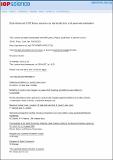Early Advanced LIGO binary neutron-star sky localization and parameter estimation
Author(s)
Berry, C P L; Farr, B; Farr, W M; Haster, C-J; Mandel, I; Middleton, H; Singer, L P; Urban, A L; Vecchio, A; Vitale, S; Cannon, K; Graff, P B; Hanna, C; Pankow, C; Price, L R; Sidery, T; Veitch, J; Ray Pitambar Mohapatra, Satyanarayan; ... Show more Show less
DownloadVitale_Early advanced LIGO.pdf (964.7Kb)
PUBLISHER_CC
Publisher with Creative Commons License
Creative Commons Attribution
Terms of use
Metadata
Show full item recordAbstract
2015 will see the first observations of Advanced LIGO and the start of the gravitational-wave (GW) advanced-detector era. One of the most promising sources for ground- based GW detectors are binary neutron-star (BNS) coalescences. In order to use any detections for astrophysics, we must understand the capabilities of our parameter-estimation analysis. By simulating the GWs from an astrophysically motivated population of BNSs, we examine the accuracy of parameter inferences in the early advanced-detector era. We find that sky location, which is important for electromagnetic follow-up, can be determined rapidly (~ 5 s), but that sky areas may be hundreds of square degrees. The degeneracy between component mass and spin means there is significant uncertainty for measurements of the individual masses and spins; however, the chirp mass is well measured (typically better than 0.1%).
Date issued
2016-06Department
MIT Kavli Institute for Astrophysics and Space ResearchJournal
Journal of Physics: Conference Series
Publisher
IOP Publishing
Citation
Berry, C P L; Farr, B; Farr, W M; Haster, C-J; Mandel, I; Middleton, H; Singer, L P et al. “Early Advanced LIGO Binary Neutron-Star Sky Localization and Parameter Estimation.” Journal of Physics: Conference Series 716 (May 2016): 012031. © 2016 IOP Publishing
Version: Final published version
ISSN
1742-6588
1742-6596